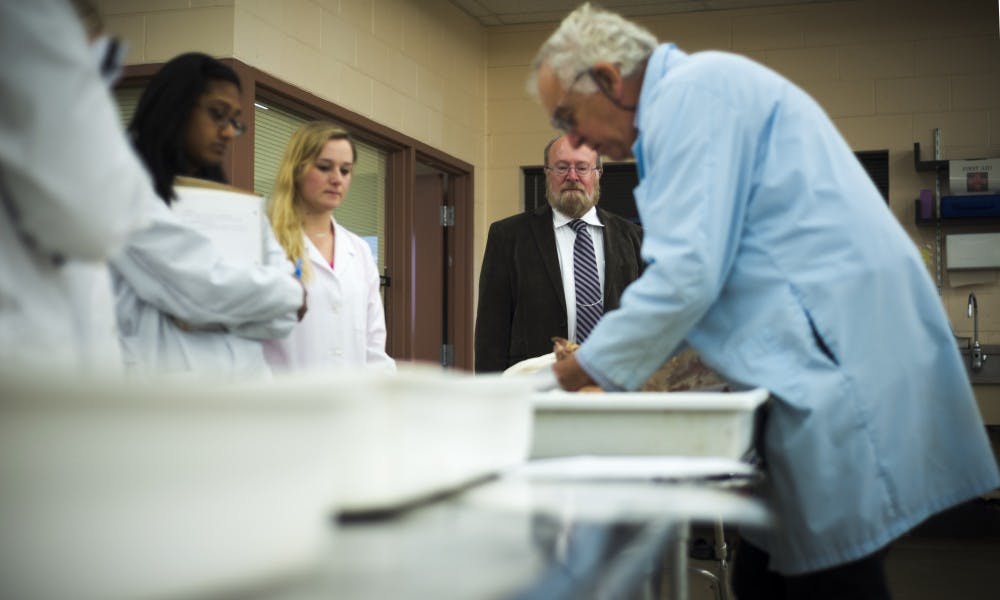
For the second year in a row, MSU’s College of Veterinary Medicine has secured the top spot in the Big Ten for its veterinary program, according to recent rankings from Quacquarelli Symonds, a higher education data provider. The College of Veterinary Medicine holds the fifth spot nationally and the twelfth spot internationally for the program.
John Baker, the dean of the College of Veterinary Medicine, attributes the program’s success to a number of factors.
“We have all the components,” he said. “We’ve got good faculty, we’ve got good students, we’ve got good training programs, we’ve got good interns, residents.”
The college has a long history — it has been around since 1910. The school has graduated more than 7,000 veterinarians since its start and the graduation rate fluctuates between 98 and 100 percent, Baker said. The college is relatively small and consists of only about 115 faculty and each graduating class averages about 115 students as well.
“Typically, about 35 of those would be out-of-state students and then the remainder is in state,” Baker said. “Around 450 veterinary students at any given time.”
The MSU Veterinary Medical Center is housed within the college and allows students to learn to treat small and large animals. It’s primarily a referral center, Baker said.
“We’re pretty much right about 30,000 referrals a year,” he said. “In human medicine, you’d call this a tertiary center. This is like the Cleveland Clinic or the Mayo Clinic. It’s not where you start out. So most of these cases that come in are being referred in.”
The College of Veterinary Medicine also has a veterinary diagnostic laboratory that is part of the college, and not all veterinary schools have this, Baker said. MSU’s laboratory is the Diagnostic Center for Population and Animal Health. The diagnostic laboratory has about the highest accession number in the country, Baker said.
The college also has a number of research focuses, including orthopedic, respiratory, epidemiology, mastitis, reproductive and ophthalmology research.
“One important thing about the research as well is that animal model informs human health,” Kristen Flory, director of marketing and communication for the College of Veterinary Medicine, said. “So many of our researchers have funding from the NIH because the research they’re doing on their animal model could impact the same disease in people, particularly ophthalmology.”
However, while the college’s rankings are high, Baker said he hopes the veterinary school will undergo major curriculum changes in the near future.
“The way that vet school works is that it’s a four-year program and students are in the classroom learning—didactic learning—for the first five semesters,” Flory said. “And then after that, they’re in clinics for the last three semesters, which is a little bit more than most schools in the U.S. do.”
Baker said he hopes the curriculum will build off of this to create a whole new approach, and said about 60 faculty members have been working on the curriculum.
“They’re starting to really pay attention to the way students nowadays learn, and they’re tailoring their teaching and delivering techniques to the student,” Flory said.
The curriculum would change from the traditional model of medical education to try to create a more integrative structure. The traditional model is to first learn anatomy, or how everything is structured, then move on to physiology and learn how bodies work normally, Baker said. After learning what it means to have a “normal” body, students move on to what is “abnormal.”
The new curriculum would attempt to address each of these components in a more integrative way. For example, when students learn about the heart, they would learn how it is structured, how it works normally, what would be considered abnormal, then how these abnormalities can be successfully treated.
The College of Veterinary Medicine is accredited by Council of Education, the American Veterinary Medical Association and the Association of American Veterinary Medical Colleges, and they lay out competencies students must have before graduation, Baker said. He said he hopes to see the curriculum will put all of these competencies into first five semesters.
“It’ll be a lot of work, there’s no question about it, but first we’ve got to get it approved,” Baker said.
At this point, an outline for the curriculum has been developed and the next step is to get it approved by the college. If approved, the university will have to approve it, then time would be spent on planning how to implement the curriculum, Baker said.
“The goal right now is to have it in place fall of ‘18,” Baker said. “Medical schools are a little different — you don’t change it all at once, you change it one year at a time.”


